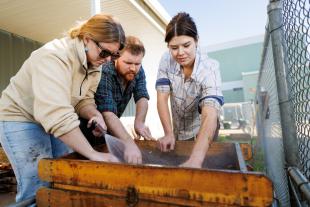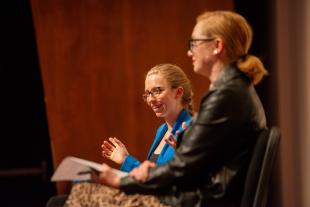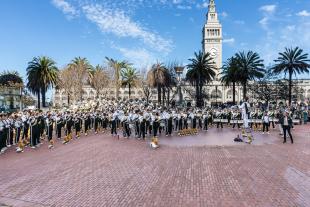Ask an Expert: What Can We Learn From the Women’s Suffrage Movement?
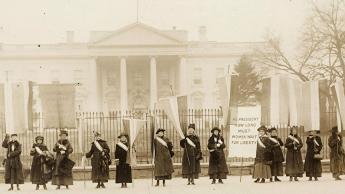
As Americans head to the polls this November, women voters are set to outnumber their male counterparts, just as they have in every national election since 1980. But more than a century ago, the legal doctrine of coverture barred most women from political participation on the national scale. Instead, they were told to trust their fathers and husbands to make the right decisions on their behalf.
The 19th amendment granting women’s right to vote was the end result of many contributing factors, including Reconstruction politics, wars, industrialization and years of grueling activism. While legislation was first proposed in 1878 to enfranchise women, it wasn’t passed by Congress until 1919. By August 1920, enough states ratified the amendment to make the law permanent. But the full story of women’s suffrage is complex.
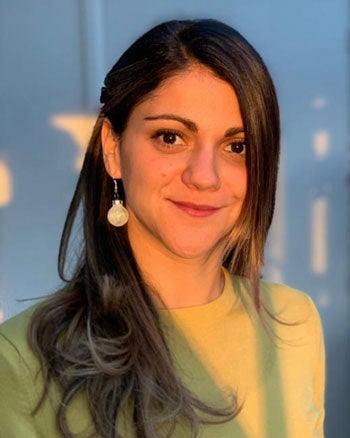
History professor Andrea Oñate-Madrazo, who teaches social movements and human rights, talked with Cal Poly News about the complicated movement that led to the enfranchisement of American women.
How did the women’s suffrage movement originate in the United States?
There are two organizational precursors critical to the women’s suffrage movement: the abolitionist movement to eradicate slavery and the temperance movement to control the consumption of alcohol.
I think that we owe a huge debt of gratitude to African American women and men who really laid the stage for what became the suffrage movement. Free Black women abolitionists and women who had formerly been slaves like Sojourner Truth, Harriet Tubman, Maria Stewart, Henrietta Purvis, Harriet Forten Purvis, Sarah Remond, and Mary Ann Cary were active in women’s rights circles, and they were joined by prominent Black men, including Frederick Douglass, Charles Lenox Remond and Robert Purvis.
Women like Elizabeth Cady Stanton and Susan B. Anthony, who we think of as the pioneers in white women’s rights, had their first exposure to activism by being involved in the abolitionist and temperance movements. Women acquire the organizational skills, the petitioning experience, and the public speaking experience that they then use to fight for suffrage.
One of the things that gets women active in the fight for suffrage is they [are] excluded from having a voice in abolitionist and temperance conventions because they are women. They begin to see the direct correlation between gender and lack of a voice.
During the Civil War, women have the expectation that, because they’re acquiring new roles, this is going to translate into greater rights after the war, predominantly the right to vote. But when the Civil War ends, women are relegated back to their traditional roles.
With the proposal of the 15th amendment which enfranchises Black men after the Civil War, interracial and mixed gender coalitions begin to deteriorate. Suffragists have to choose between insisting on universal rights or accepting the priority of Black male suffrage.
Stanton and Anthony insist that Black men should not receive the right to vote before white women. They start channeling their efforts toward voting for white women. They now see Black men and women as competitors for the same right, creating this false paradigm in their mind.
Stanton and Anthony’s remarks about Black men evokes intense anger on the part of Black suffragists, including people who had been longtime allies like Douglass and Frances Ellen Watkins Harper.
How did this translate to the activism of the early 20th century?
In the early 20th century, we see the formation of two key organizations and they are going to be the bastions of white female suffrage. The National American Women Suffrage Association is made up of older women who tend to be upper middle class. Some of them are married to men in positions of power or who have close friends in positions of power, so they really try to work within the system.
The National Women’s Party is much more radical, it’s made up of a younger demographic, it’s more heterogeneous. Yes, there are middle class women including Alice Paul and Lucy Burns, but they also attract a lot of working-class women and socialists. As a social movement case study, it’s really interesting to see how the union of a more tame, moderate, institutional organization and a more radical, belligerent, anti-systems organization are able to cover all the bases to fight for the same end goal of women’s suffrage.
They organized consumer boycotts, they hounded elected officials with petitions, they walked off their jobs, they picketed on the streets, and they wrote and spoke so powerfully that it made constitutional reform imaginable and eventually possible. This doesn’t happen overnight. Those in power do not all of a sudden see the light and realize the error of their ways. This is the product of contentious and conscientious struggle.
At the time, these women fighting for suffrage are considered extremely radical. A lot of them are ostracized and experience public shaming. Many go to jail for defying laws. Susan B Anthony votes in an election in New York in 1872, and the reason they don’t sentence her is because they don’t want her to take the case to the Supreme Court. Her lawyer pays her bail, and she is devastated because being released meant that she would never be able to take her case to the Supreme Court. She would have to settle for rattling the system through the local courts instead. A lot of times when we look back at movements like suffrage or civil rights, we fail to account for how difficult it was. And that is very much the case with the suffragettes, who are breaking down barriers, but who are doing so at enormous costs to themselves, their families and their livelihoods.
That certainly challenges the narrative many are taught about the suffrage movement that evokes the image of women in white politely marching with a banner, and suffrage is joyously handed to them.
That narrative is so problematic. And I see this with my students today. If change doesn’t happen like that [snaps], they get frustrated. I think we need to be very aware of the fact that any progressive change has taken a ton of work, perseverance, determination, patience — a lot of patience — and a lot of setbacks. The rights that we enjoy are a product of struggle and the product of demanding rights. They have never been given freely by those in power out of their own kind nature and goodwill.
Securing women’s voting rights required grueling years of single-minded political advocacy with significant campaigns for support in Washington but also in dozens of states to convince legislators to ratify an amendment to the U.S. Constitution. This sheer effort shouldn’t be ignored because it feeds into the idea that, if these excluded, downtrodden, marginalized groups can wait their turn or bide their time, then miraculously this change is just going to appear. That’s historically not accurate.
What were the arguments driving the debate?
You have this argument about human rights — equal rights between men and women as human. Women are also saying, “As citizens, we have to obey laws, but we don’t have a voice in framing the laws we’re expected to obey.”
There are also women arguing that some married women now have the right to own property, and they also pay taxes. They’re saying that we are being taxed without representation. And “no taxation without representation” has a lot of weight in a country that fought its war of independence based on that principle.
In terms of less noble arguments, you have many white suffragists who see themselves as superior to African American men and women. After the 15th amendment passed, these women argue that, if you give white women the right to vote, it might help cancel out the influence of newly enfranchised Black men.
You also have several suffrage activists who view the world through a gendered lens [with] separate spheres for men and women. These activists believe that by nature, women were housekeepers, caregivers, trainers of women’s virtue, and that they had a unique perspective that should be brought to the table.
An organization forms in 1911 specifically to oppose women’s rights to vote. This is an organization created by women, called the National Association Opposed to Women’s Suffrage. They said that the majority of women didn’t actually want the right to vote because they believed that the men in their lives accurately represented the political will of women around the US. They also suggested that women did not want to or care to vote because this would mean there would be competition between women and men instead of cooperation. This could sow disputes in the heart of the home and family.
Others said that voting would make women waste time and energy that they should be devoting to their home, their husbands and their children. They also argued that this could be very problematic because men could not grant suffrage to only on those who they deemed worthy, which frightened many in power.
Many industrialists, distillers and brewers felt threatened by the reforming potential of women voters. They believed women would act out their natural maternal instinct to do things like prohibit alcohol consumption, interfere with business practices, and regulate working conditions and hours.
What happened after the amendment was passed?
That same year 1920 was a [national] election year, just like 2020. On Nov. 2 of 1920, more than 8 million women across the US vote in a national election for the first time. But it takes over 60 years for the remaining 12 states to ratify the 19th amendment, and Mississippi is the last to do so in 1984.
By the time that women’s suffrage finally has teeth, the movement is largely white and middle class. And Black women are largely excluded through things like literacy tests and property requirements for voting. Even after the 19th amendment passes, when women come together to say “Okay, what comes next?” the issue of Black female suffrage is sidelined by women like Alice Paul, who says that Black women are being denied the right to vote, because they are Black, not because they are women. Paul says the women’s movement should not take this on because they’d lose out. The women’s movement largely dissolves after the passing of the 19th amendment. One of the things I think is most difficult to wrap your mind around — or sad — is that a lot of the women who were suffragettes, who fought for the right to vote, join the KKK in the 1920s.
In much of the country, there are hurdles like poll taxes and literacy tests that keep Black [and] Native American voters disenfranchised. And that’s going to be the case until the passage of the Voting Rights Act in 1965 which outlaws discriminatory voting practices. Some of the arguments that are made in favor of the act parallel the arguments that are made for enfranchisement in the 1910s. But there’s a long stretch between 1920 and 1965. [The 19th amendment] calms the temperament and the thirst for social justice for a number of years so the argument is that “We already gave women the right to vote, what more do you want?”
What are some of the biggest lessons learned from the women’s suffrage movement?
One of the things we can learn is that the most important change comes from concrete laws, because otherwise it’s transient. A key to tackling the challenges women are facing today is that we need more women at the table making decisions and that goes across the board: not just in the political realm but in business, intellectual, cultural and social spheres.
The US ranks 75th out of 193 countries in terms of women’s representation in government, and this is truly terrifying for a country that prides itself on being the land of the free and the home of the brave. If you have women at the table making decisions, enacting laws, they’re going to be looking out for issues that predominantly concern them as women, knowingly or not.
American women have a decisive role to play at the polls, and they should seize it. Before we declare victory for the women’s movement on the suffrage centennial, I think we have to remember the true aims of the suffrage movement, which were liberation and radical social change. Not just the right to cast a ballot on Election Day. Suffrage proved more easily attainable than many of these goals, which are still ours to pursue. The job is by no means done.

